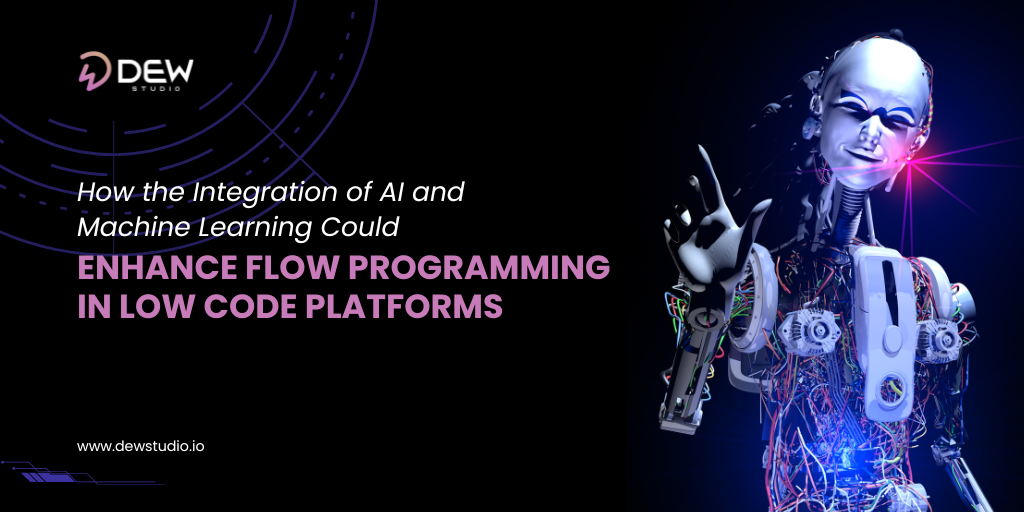
Are you ready to transform the way you develop software? With over 60% of organizations now adopting AI and machine learning in their development processes. The demand for more innovative, faster solutions has never been higher. Enter flow programming, a key feature in low-code platforms that simplifies the software creation process through visual workflows.
As AI and machine learning integration become more prevalent, flow programming is set to undergo a revolution, evolving into a more intuitive, efficient, and powerful tool. This integration promises to enhance automation, optimize decision-making, and significantly reduce the time and effort required to bring complex applications to life.
Understanding Flow Programming in Low-Code Platforms
What is Flow Programming?
Flow programming is a visual approach to software development that allows developers to create applications by designing workflows through a series of connected steps or “flows.” In low code platforms, this method simplifies app development by enabling users to drag and drop components, reducing the need for extensive coding knowledge. This intuitive approach makes it easier to build complex applications quickly, even for those with limited technical expertise.
Current Capabilities of Flow Programming
It offer a streamlined way to automate tasks, manage data flow, and create user interfaces. Developers can focus on logic and functionality rather than getting bogged down in code. Current capabilities include designing workflows, integrating various services, and building responsive applications with minimal manual coding.
Limitations Without AI/ML Integration
Despite its benefits, flow programming has limitations in its current form. Without AI/ML integration, it can struggle with automating complex decision-making processes, optimizing performance, and handling large-scale data analytics. Additionally, the lack of advanced predictive capabilities may require more manual intervention and fine-tuning, which can slow down development and reduce efficiency.
The Role of AI in Enhancing Flow Programming
Automating Repetitive Tasks:
AI can significantly improve efficiency in flow programming by automating repetitive tasks. For example, AI algorithms can detect patterns in the development process and automatically generate or suggest the next steps. As a result, manual input and workflow creation are improved.
Intelligent Decision-Making:
AI enhances decision-making within flow programming by analyzing vast amounts of data to suggest optimal paths and solutions. This leads to smarter workflows, where the system can recommend the best course of action based on past performance, user behavior, or real-time data analysis.
Real-World Examples:
AI-Driven Flow Suggestions:
Platforms can use AI to offer developers real-time suggestions on how to streamline or enhance their workflows.
Error Detection:
AI can automatically identify and flag potential errors in the flow, offering corrective actions before they become significant issues, thus improving the overall reliability of the application.
Machine Learning’s Impact on Flow Programming
Predictive Analytics: Machine learning algorithms play a pivotal role in enhancing flow programming by leveraging predictive analytics. These algorithms can analyze historical data to forecast potential outcomes, enabling the system to recommend the most efficient and effective flow paths. This predictive capability helps developers make data-driven decisions, reducing trial and error and streamlining the development process.
Adaptive Learning: Machine learning models also bring adaptive learning to flow programming. By continuously learning from user interactions, these models can optimize workflows over time. As the system gathers more data, it becomes better at predicting user needs, suggesting improvements, and adapting flows to meet evolving requirements, leading to more intelligent and responsive applications.
Key Statistics
Adoption Rates: Over 70% of organizations are integrating AI and machine learning into their low code platforms, with adoption rates rising steadily year over year.
Efficiency Gains: Studies show that AI/ML integration can improve development efficiency by up to 40%, reducing time-to-market and cutting development costs significantly.
Market Growth: The AI and low code platform market is projected to grow at a compound annual growth rate (CAGR) of 25% over the next 5-10 years, making it a multi-billion dollar industry by 2030.
Benefits of AI/ML Integration for Businesses Using Low Code Platforms
Increased Development Speed: AI and machine learning integration can significantly accelerate the app development process in low code platforms. By automating routine tasks and reducing the need for extensive manual coding, these technologies enable developers to build applications faster. AI-driven tools can automatically generate code snippets, suggest optimal workflows, and even predict the next steps in development, allowing businesses to launch products quicker and stay competitive in the market.
Enhanced User Experience: AI and ML also play a crucial role in creating more personalized and user-friendly applications. These technologies can analyze user behavior, preferences, and feedback in real-time, allowing developers to design interfaces and features that cater to individual user needs. As a result, businesses can offer a more engaging and tailored experience to their customers, which can lead to higher satisfaction and retention rates.
Cost Reduction: The efficiency gains from AI/ML integration directly translate into cost savings for businesses. By automating repetitive tasks and optimizing workflows, these technologies reduce the amount of manual labor required, lowering development costs. Moreover, faster development cycles mean that businesses can bring products to market sooner, maximizing revenue potential. Additionally, AI/ML’s ability to detect errors early in the development process helps avoid costly fixes later on, further contributing to overall cost reduction.
Future Trends and Innovations
AI and Flow Programming Evolution: As AI technology advances, we may see the emergence of fully autonomous flow programming, where AI handles every aspect of development, from planning to deployment. This could lead to more sophisticated AI-driven development environments, allowing developers to focus on strategic tasks while AI manages the technical details.
The Role of Citizen Developers: These innovations will empower citizen developers, enabling non-technical users to build complex applications with ease. With AI handling the heavy lifting, low code platforms will become even more accessible, allowing businesses to innovate faster and more efficiently. The integration of AI in low code platforms is set to redefine the future of app development.
Conclusion
In this blog, we’ve explored how the integration of AI and machine learning can significantly enhance flow programming in low code platforms. From accelerating development speed and improving user experience to reducing costs, the benefits are clear. We also touched on future trends, where AI-driven advancements will further empower both developers and citizen developers.
Ready to experience the future of app development? Explore how our low code platform, DEWStudio leverages AI and machine learning to revolutionize flow programming.
Don’t miss out—start your trial or schedule a demo today to see how it can transform your development process.


